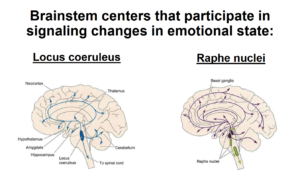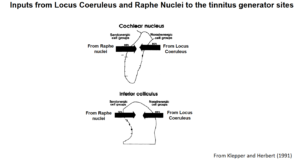From international links (lat the botten more links coming)
- Contributions of the Brainstem to the auditory and non-auditory components of Tinnitus James A. Kaltenbach, Ph.D Department of Neurosciences Lerner Research Institute and Head and Neck Institute Cleveland Clinic https://www.ncrar.research.va.gov/Conference/Documents/PPT/Kaltenbach.pdf
Outline of this presentation
Part 1- The brainstem as a tinnitus generator
Part 2-The brainstem as a tinnitus modulator
Part 3-The brainstem’s role in tinnitus comorbidities
More …
Pons – Wikipedia
https://en.wikipedia.org/wiki/Pons
Disabling tinnitus and third nerve palsy following pontinehemorrhage: Application of ICF framework – PMC https://www.ncbi.nlm.nih.gov/pmc/articles/PMC10825810/
22366 PDFs | Review articles in PONS tinnitus https://www.researchgate.net/topic/Pons~Tinnitus/publications
Abrupt onset of sensorineural hearing loss and tinnitus in apatient with capillary telangiectasia of the pons – PubMed https://pubmed.ncbi.nlm.nih.gov/12296344/
Pons: What It Is, Function & Anatomy NB TINNITUS AND VIRTIGO
https://my.clevelandclinic.org/health/body/23003-pons
Brainstem hemorrhage | MedLink Neurology
https://www.medlink.com/articles/brainstem-hemorrhage
More 2024-07-12
The olivocochlear system (Olivocochlear system – Wikipedia) is a component of the auditory system involved with the descending control of the cochlea. Its nerve fibres, the olivocochlear bundle (OCB), form part of the vestibulocochlear nerve (VIIIth cranial nerve, also known as the auditory-vestibular nerve), and project from the superior olivary complex in the brainstem (pons) to the cochlea.[1]
Olivary omplex – Cochlear nucleus
Fig above text: The basic MOC acoustic reflex. The auditory nerve responds to sound, sending a signal to the cochlear nucleus. Afferent nerve fibres cross the midline from the cochlear nucleus to the cell bodies of the MOCS (located near the MSOC), whose efferent fibres project back to the cochlea (red). In most mammals, the majority of the reflex is ipsilateral (shown as a thicker line), effectuated by the crossed MOCS.
Increased contralateral suppression of otoacoustic emissions indicates a hyperresponsive medial olivocochlear system in humans with tinnitus and hyperacusis https://pubmed.ncbi.nlm.nih.gov/25231612/ ”… The present data, combined with previous human and animal data, indicate that neural pathways involving every major division of the cochlear nucleus manifest hyperactivity and/or hyperresponsiveness in tinnitus and/or low SLT (Sound-level tolerance). The overactivation may develop in each pathway separately. However, a more parsimonious hypothesis is that top-down neuromodulation is the driving force behind ubiquitous overactivation of the auditory brain stem and may correspond to attentional spotlighting on the auditory domain in tinnitus and hyperacusis.”
pons microbleeding in the middle – Sök på Google
https://www.google.com/search?q=pons+microbleeding+in+the+middle&sca_esv=775099f247dfe703&udm=2&biw=384&bih=721&sxsrf=ADLYWILxOAW2OLyJ7n2eehMmn6U-YicdPw%3A1720709042940&ei=su-PZo-KOZvIwPAPkImnaA&oq=pons+microbleeding+in+the+middle&gs_lp=EhNtb2JpbGUtZ3dzLXdpei1zZXJwIiBwb25zIG1pY3JvYmxlZWRpbmcgaW4gdGhlIG1pZGRsZTIIEAAYgAQYogQyCBAAGIAEGKIESJxeUJ4NWLVGcAB4AJABAZgBqBCgAbJkqgETMS4yLjAuMi4wLjIuMi40LjEuMbgBA8gBAPgBAZgCDqAC7l_CAgQQIxgnwgIEEB4YCsICBBAhGAqYAwCIBgGSBw8xLjIuMC4yLjEuMC4zLjWgB9wk&sclient=mobile-gws-wiz-serp
pons anatomy – Sök på Google
https://www.google.com/imgres?imgurl=https%3A%2F%2Fprod-images-static.radiopaedia.org%2Fimages%2F53508826%2FBrainstem_images.001_big_gallery.jpeg&tbnid=jwz1oyTdAmNdEM&vet=1&imgrefurl=https%3A%2F%2Fradiopaedia.org%2Fcases%2Flower-pons-anatomy-cn-vii-diagram&docid=8A9RV5osmX-jCM&w=630&h=630&source=sh%2Fx%2Fim%2Fm4%2F2&kgs=c8eb321722ed6b66&shem=abme%2Ctrie#vhid=jwz1oyTdAmNdEM&vssid=mosai
Pons – The Definitive Guide | Biology Dictionary
Pons (Chapter 3) – How Brain Arousal Mechanisms Work BvS LC
https://www.cambridge.org/core/books/how-brain-arousal-mechanisms-work/pons/07E9D38392A2D9465B5DF52FA5B10E15
A Pontine Region is a Neural Correlate of the Human Affective Processing Network – PMC Pons
https://www.ncbi.nlm.nih.gov/pmc/articles/PMC4740328/
Pontine Raphe Nucleus – an overview | ScienceDirect Topics exist in Pons
https://www.sciencedirect.com/topics/neuroscience/pontine-raphe-nucleus
Pons: What It Is, Function & Anatomy Cleveland clinic
https://my.clevelandclinic.org/health/body/23003-pons
Retucular Activation system

https://study.com/academy/lesson/reticular-activating-system-definition-function.html
RAS dysfunctions
”A series of hypotheses are advanced to account for the role of these nuclei in such diverse disorders as schizophrenia, post-traumatic stress disorder, REM behavior disorder, Parkinson’s disease and narcolepsy” https://study.com/academy/lesson/reticular-activating-system-definition-function.html (As above)
Topological features of limbic dysfunction in chronicity of tinnitus with intact hearing: New hypothesis for ‘noise-cancellation’ mechanism https://www.sciencedirect.com/science/article/abs/pii/S0278584621002189
” … Highlights
- Prefrontal cortex is most important to network integrity in acute tinnitus.
- High interactions in hippocampus and amygdala are involved in chronic tinnitus.
- Brain network topological properties altered across prefrontal-limbic-subcortical regions in the chronicity of tinnitus.
- The observed ‘hubs’ in brain network of tinnitus contributing to a new hypothesis for ‘noise-cancellation’ mechanism.
Suffering from chronic tinnitus, chronic neck pain, or both: Does it impact the presence of signs and symptoms of central sensitization?
https://journals.plos.org/plosone/article?id=10.1371/journal.pone.0290116
” Chronic subjective tinnitus is a prevalent symptom, which has many similarities with chronic pain. Central sensitization is considered as a possible underlying mechanism of both symptoms. Central sensitization has already been investigated in chronic pain populations but not in patients with chronic subjective tinnitus. Therefore, the main objective of this cross-sectional study was to compare signs and symptoms, indicative for central sensitization, in tinnitus patients with and without chronic idiopathic neck pain, patients with chronic idiopathic neck pain only, and healthy controls. Also, differences in psychological and lifestyle factors, possibly influencing the association between central sensitization and tinnitus, were examined as well as correlations between signs and symptoms of central sensitization, and tinnitus, pain, psychological and lifestyle factors. Differences in signs and symptoms of central sensitization were examined using the self-report Central Sensitization Inventory and QST protocol (local and distant mechanical and heat hyperalgesia, conditioned pain modulation). Tinnitus, pain, psychological and lifestyle factors were evaluated using self-report questionnaires. Symptoms of central sensitization and local mechanical hyperalgesia were significantly more present in both tinnitus groups, compared to healthy controls, but were most extensive in the group with chronic tinnitus+chronic idiopathic neck pain. Distant mechanical hyperalgesia, indicative for central sensitization, was only observed in the group with both chronic tinnitus+chronic idiopathic neck pain. This group also displayed a significantly higher psychological burden and poorer sleep than patients with chronic tinnitus only and healthy controls. Signs and symptoms of central sensitization were also shown to be associated with tinnitus impact, pain-related disability, psychological burden and sleep disturbances. This study shows preliminary evidence for the presence of central sensitization in patients with chronic tinnitus+chronic idiopathic neck pain. This could be explained by the higher perceived tinnitus impact, psychological burden and sleep problems in this group.”
Locus Coerulues
Anatomically and functionally distinct locus coeruleus efferents mediate opposing effects on anxiety-like behavior – ScienceDirect
https://www.sciencedirect.com/science/article/pii/S2352289520300746
Illuminating the locus coeruleus: control of posture and arousal – PMC
https://www.ncbi.nlm.nih.gov/pmc/articles/PMC8851494/#:~:text=Optogenetic%20stimulation%20of%20the%20locus,to%20that%20seen%20in%20cataplexy.
Much more Locus Coeruleus at other places and also coming here – will try to integrate different dysfunctional processes in the brain stem with thee rest of the brain… (2024-07-12)


